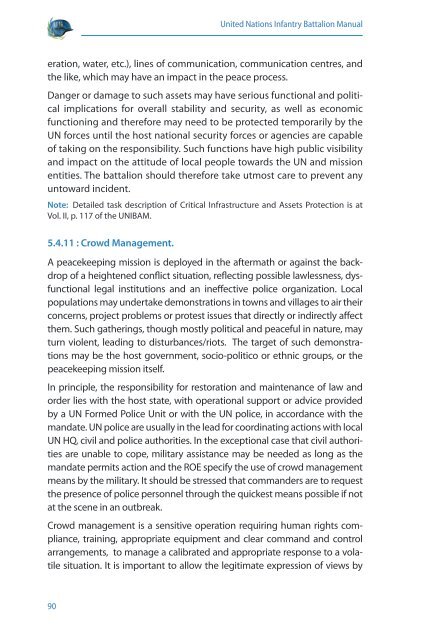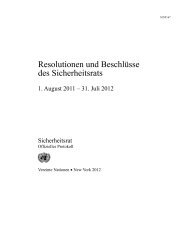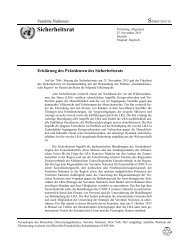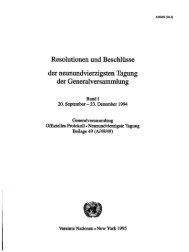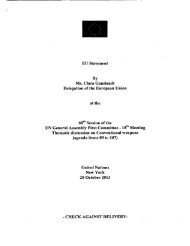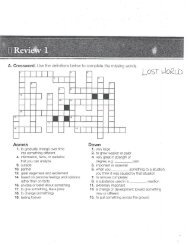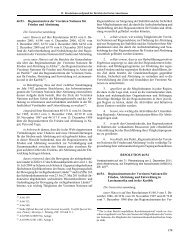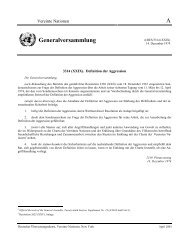United Nations Infantry Battalion Manual - the United Nations
United Nations Infantry Battalion Manual - the United Nations
United Nations Infantry Battalion Manual - the United Nations
You also want an ePaper? Increase the reach of your titles
YUMPU automatically turns print PDFs into web optimized ePapers that Google loves.
90<br />
<strong>United</strong> <strong>Nations</strong> <strong>Infantry</strong> <strong>Battalion</strong> <strong>Manual</strong><br />
eration, water, etc.), lines of communication, communication centres, and<br />
<strong>the</strong> like, which may have an impact in <strong>the</strong> peace process.<br />
Danger or damage to such assets may have serious functional and political<br />
implications for overall stability and security, as well as economic<br />
functioning and <strong>the</strong>refore may need to be protected temporarily by <strong>the</strong><br />
UN forces until <strong>the</strong> host national security forces or agencies are capable<br />
of taking on <strong>the</strong> responsibility. Such functions have high public visibility<br />
and impact on <strong>the</strong> attitude of local people towards <strong>the</strong> UN and mission<br />
entities. The battalion should <strong>the</strong>refore take utmost care to prevent any<br />
untoward incident.<br />
Note: Detailed task description of Critical Infrastructure and Assets Protection is at<br />
Vol. II, p. 117 of <strong>the</strong> UNIBAM.<br />
5.4.11 : Crowd Management.<br />
A peacekeeping mission is deployed in <strong>the</strong> aftermath or against <strong>the</strong> backdrop<br />
of a heightened conflict situation, reflecting possible lawlessness, dysfunctional<br />
legal institutions and an ineffective police organization. Local<br />
populations may undertake demonstrations in towns and villages to air <strong>the</strong>ir<br />
concerns, project problems or protest issues that directly or indirectly affect<br />
<strong>the</strong>m. Such ga<strong>the</strong>rings, though mostly political and peaceful in nature, may<br />
turn violent, leading to disturbances/riots. The target of such demonstrations<br />
may be <strong>the</strong> host government, socio-politico or ethnic groups, or <strong>the</strong><br />
peacekeeping mission itself.<br />
In principle, <strong>the</strong> responsibility for restoration and maintenance of law and<br />
order lies with <strong>the</strong> host state, with operational support or advice provided<br />
by a UN Formed Police Unit or with <strong>the</strong> UN police, in accordance with <strong>the</strong><br />
mandate. UN police are usually in <strong>the</strong> lead for coordinating actions with local<br />
UN HQ, civil and police authorities. In <strong>the</strong> exceptional case that civil authorities<br />
are unable to cope, military assistance may be needed as long as <strong>the</strong><br />
mandate permits action and <strong>the</strong> ROE specify <strong>the</strong> use of crowd management<br />
means by <strong>the</strong> military. It should be stressed that commanders are to request<br />
<strong>the</strong> presence of police personnel through <strong>the</strong> quickest means possible if not<br />
at <strong>the</strong> scene in an outbreak.<br />
Crowd management is a sensitive operation requiring human rights compliance,<br />
training, appropriate equipment and clear command and control<br />
arrangements, to manage a calibrated and appropriate response to a volatile<br />
situation. It is important to allow <strong>the</strong> legitimate expression of views by


